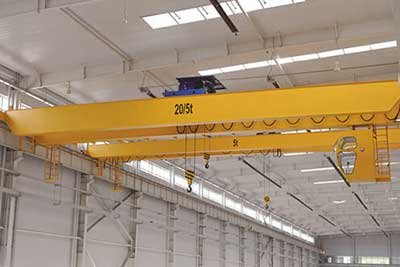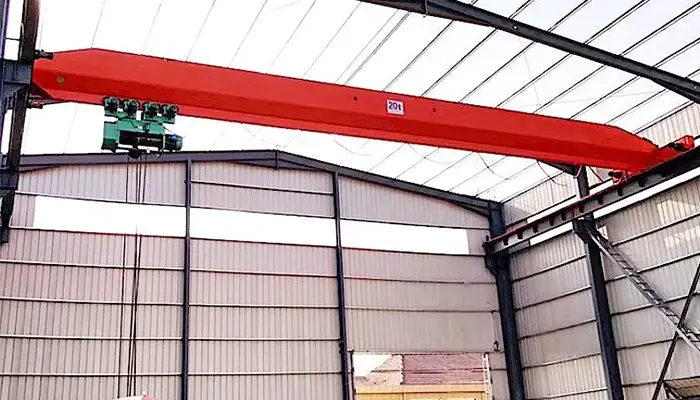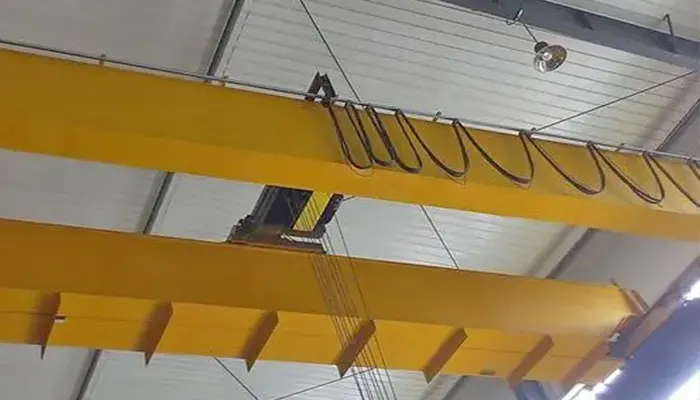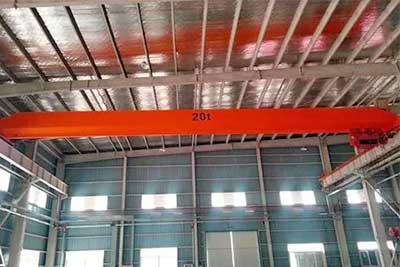Choosing the Right 20 Ton Overhead Crane for Your Business Needs
Selecting Right 20 Ton Overhead Crane for Your Business
In the busy workshop of industrial manufacturing , efficiency is the name of the game. Whether you're in manufacturing, construction, or logistics, having the right equipment can make all the difference. That's where overhead cranes come into play. These mighty machines are the workhorses of heavy lifting, streamlining operations and boosting productivity. But choosing the right overhead crane isn't just about picking the biggest or fanciest one. It's about finding the perfect fit for your business needs.
Imagine trying to lift a heavyweight with a flimsy rope. It's a recipe for disaster. The same goes for selecting an overhead crane that doesn't match your lifting requirements. The consequences can range from inefficiency and downtime to safety hazards and costly repairs. That's why selecting the right overhead crane is crucial. It ensures smooth operations, enhances productivity, and most importantly, keeps your workforce safe.
Choosing the right overhead crane may seem like a daunting task, but fear not! We're here to guide you through the decision-making process step by step. From assessing your business needs to evaluating crane designs and performance metrics, we'll cover it all. By the end of this guide, you'll be equipped with the knowledge and insights to make an informed decision and find the perfect 20 ton overhead crane for your business.
Assessing Business Needs
In order to select the right 20 ton overhead crane for your business, it's essential to have a clear understanding of your lifting requirements and operational constraints.
Know Your Lifting Requirements
First and foremost, take a close look at your lifting requirements. Consider the types of loads you'll be handling, their weights, sizes, and how frequently you'll need to lift them. Are you dealing with heavy machinery components, large containers, or delicate materials? Understanding your lifting requirements will help determine the load capacity and capabilities needed from your overhead crane.
Identifying Operational Constraints
Next, identify any operational constraints that may impact your overhead crane selection. This could include factors such as the layout of your facility, available space for crane installation, ceiling height, and any other physical limitations. Additionally, consider environmental factors such as temperature, humidity, and potential hazards that may affect crane operations. By identifying these constraints upfront, you can narrow down your options and ensure that the chosen overhead crane is compatible with your operational requirements.
By thoroughly assessing your business needs, including lifting requirements and operational constraints, you'll be better equipped to choose the right 20 ton overhead crane that meets your specific requirements. In the next section, we'll delve into the different types of 20 ton overhead cranes available, providing insights into their functionalities and suitability for various applications. Stay tuned as we continue our journey towards finding the perfect overhead crane solution for your business.
Overview of 20 Ton Overhead Cranes
Before diving into the specifics of selecting the right overhead crane for your business, it's crucial to have a solid grasp of what exactly a 20 ton overhead crane is and the different types available. Let's explore:
An overhead crane, also known as a bridge crane or overhead traveling crane, is a type of material handling equipment used to lift and move heavy loads horizontally within a facility. A 20 ton overhead crane, as the name suggests, is designed to lift loads weighing up to 20 tons. These cranes typically consist of a bridge, which travels along elevated runways, supported by end trucks. The bridge is equipped with a hoist, which is used to lift and lower loads.
The functionality of a 20 ton overhead crane is straightforward yet powerful. It provides a safe and efficient means of lifting and transporting heavy materials and equipment, reducing manual labor and streamlining operations in a variety of industries, including manufacturing, construction, and logistics.
Types of 20 Ton Overhead Cranes Available
There are several types of 20 ton overhead cranes available, each designed to meet specific lifting requirements and operational needs:
 Double girder overhead crane 20 ton for sale, Check types of double girder 20 ton overhead cranes
Double girder overhead crane 20 ton for sale, Check types of double girder 20 ton overhead cranes Single Girder Overhead Crane: This type of crane features a single girder bridge supported by end trucks. Single girder cranes are known for their simplicity, versatility, and cost-effectiveness, making them suitable for a wide range of applications.
Double Girder Overhead Crane: Double girder cranes have two girders running parallel to each other, providing increased stability and load-bearing capacity compared to single girder designs. These cranes are ideal for heavy-duty lifting applications and environments with high lifting demands.
Top Running Overhead Crane: In a top running overhead crane, the bridge travels along rails mounted on the top of the runway beams. This configuration allows for maximum hook height and lifting capacity, making it suitable for applications where vertical space is a constraint.
By understanding the different types of 20 ton overhead cranes available and their functionalities, you can begin to narrow down your options and identify which crane design best suits your specific lifting requirements and operational needs. In the next section, we'll explore the factors to consider when choosing between single and double girder overhead cranes, providing insights into their respective advantages and applications. Stay tuned as we continue our journey towards finding the perfect overhead crane solution for your business.
Factors to Consider
Selecting the right 20 ton overhead crane involves careful consideration of various factors to ensure it meets your business needs and operational requirements. Let's explore the key factors:
Load Capacity
One of the most critical factors to consider when choosing an overhead crane is its load capacity. Assess the heaviest loads you'll need to lift and ensure the crane's capacity exceeds that weight. It's crucial to account for potential future growth in load requirements to avoid outgrowing the crane's capacity prematurely.
Span and Height Requirements
Consider the span and height of your facility to determine the appropriate size and configuration of the overhead crane. Ensure the crane's span can cover the entire working area, and its lifting height accommodates the tallest loads you'll handle. Additionally, take into account any obstructions or constraints that may affect crane movement and clearance.
Operational Environment
Evaluate the operational environment where the overhead crane will be used. Factors such as temperature extremes, dust, moisture, and corrosive substances can impact crane performance and longevity. Choose a crane with appropriate features and materials to withstand the conditions in your facility and ensure reliable operation.
Safety Considerations
Safety should always be a top priority when selecting an overhead crane. Look for safety features such as overload protection, emergency stop buttons, and anti-collision systems to minimize the risk of accidents and injuries. Ensure the crane complies with relevant safety regulations and standards to maintain a safe working environment for your employees.
Budget Constraints
While it's essential to invest in a high-quality overhead crane that meets your requirements, it's also important to consider budget constraints. Evaluate the upfront costs of purchasing and installing the crane, as well as ongoing maintenance and operating expenses. Balance your budget considerations with the need for a crane that offers the necessary features and performance to support your business operations effectively.
By carefully considering these factors—load capacity, span and height requirements, operational environment, safety considerations, and budget constraints—you can make an informed decision when selecting the right 20 ton overhead crane for your business. In the next section, we'll delve into the comparison between single and double girder overhead cranes, providing insights into their respective advantages and applications. Stay tuned as we continue our journey towards finding the perfect overhead crane solution for your business.
Comparison of Single Girder vs. Double Girder Designs
Choosing between single girder and double girder designs is a crucial decision when selecting a 20 ton overhead crane. Let's explore the key differences and pros and cons of each design:
Key Differences Between Single Girder and Double Girder Cranes
Structural Configuration:
Single Girder Crane: Features a single horizontal beam (girder) running along the length of the crane bridge.
Double Girder Crane: Consists of two parallel horizontal beams (girders) spanning the width of the crane bridge.
Load Capacity:
Single Girder Crane: Generally has a lower load capacity compared to double girder cranes.
Double Girder Crane: Offers higher load capacity due to its robust structural design and greater stability.
Height Clearance:
Single Girder Crane: Provides less hook height compared to double girder cranes, making it suitable for applications with lower ceiling heights.
Double Girder Crane: Offers greater hook height, allowing for increased lifting height and clearance for taller loads.
Cost:
Single Girder Crane: Typically has a lower upfront cost and may be more economical for smaller-scale operations or budgets.
Double Girder Crane: Involves higher manufacturing and installation costs but offers superior performance and load-handling capabilities.
Pros and Cons of Each Design
Single Girder Crane:
Pros:
Cost-Effective: Lower upfront cost makes it an economical choice for many businesses.
Versatility: Suitable for a wide range of applications, including light to medium-duty lifting tasks.
Compact Design: Requires less space for installation, making it ideal for facilities with limited overhead clearance.Cons:
Lower Load Capacity: Not as suitable for heavy-duty lifting applications compared to double girder cranes.
Reduced Stability: Single girder design may result in slightly less stability and control, especially when handling heavier loads. Double Girder Crane:
Double Girder Crane:
Pros:
High Load Capacity: Offers superior load-handling capabilities, making it ideal for heavy-duty lifting operations.
Enhanced Stability: Dual girder configuration provides increased stability and control, particularly when handling large and bulky loads.
Greater Hook Height: Allows for increased lifting height and clearance for taller loads, offering more flexibility in lifting operations.
Cons:
Higher Cost: Involves higher upfront costs compared to single girder cranes, which may be a limiting factor for some businesses.
Larger Footprint: Requires more space for installation and operation due to its dual girder configuration, which may not be feasible for facilities with limited space.
By weighing the pros and cons of each design against your specific operational requirements and budget constraints, you can make an informed decision when selecting between single girder and double girder 20 ton overhead cranes. In the next section, we'll delve into the evaluation of efficiency and performance metrics for overhead cranes, providing insights into their operational capabilities and suitability for different applications. Stay tuned as we continue our journey towards finding the perfect overhead crane solution for your business.
Evaluating Efficiency and Performance
Efficiency and performance are paramount when selecting a 20 ton overhead crane for your business. Let's delve into the key aspects to consider:
Performance Metrics
- Lifting Speed: The lifting speed of an overhead crane directly impacts productivity. Faster lifting speeds can reduce cycle times and increase throughput, enhancing overall operational efficiency.
- Precision: Precision in load handling is essential, particularly in industries where accuracy is critical. Evaluate the crane's ability to position loads with accuracy and consistency, minimizing the risk of damage or errors.
- Reliability: Reliability is crucial for minimizing downtime and maintaining productivity. Consider factors such as mean time between failures (MTBF) and availability of spare parts and service support when assessing the reliability of an overhead crane.
Efficiency Considerations
- Power Consumption: Assess the power consumption of the overhead crane to ensure it aligns with your energy efficiency goals. Look for features such as variable frequency drives (VFDs) and regenerative braking systems that help optimize energy usage.
- Maintenance Requirements: Consider the maintenance requirements of the overhead crane, including scheduled inspections, lubrication, and component replacements. Opt for a crane design that minimizes maintenance downtime and costs while maximizing reliability and longevity.
- Lifecycle Costs: Evaluate the total lifecycle costs of the overhead crane, including upfront investment, maintenance, energy consumption, and potential downtime costs. Balancing initial costs with long-term operational savings can help you make a more informed decision.
By carefully evaluating performance metrics such as lifting speed, precision, and reliability, as well as efficiency considerations including power consumption and maintenance requirements, you can select a 20 ton overhead crane that maximizes productivity, minimizes operational costs, and meets your business needs. In the next section, we'll explore safety considerations when operating overhead cranes, highlighting the importance of implementing robust safety measures to protect workers and equipment. Stay tuned as we continue our journey towards finding the perfect overhead crane solution for your business.
Compliance with Regulations and Standards
Ensuring compliance with safety regulations and standards is essential when operating a 20 ton overhead crane. Let's delve into the details:
Overview of Relevant Safety Regulations
- Occupational Safety and Health Administration (OSHA): OSHA sets forth regulations and standards to ensure safe working conditions for employees. Specific regulations related to overhead crane operation include 29 CFR 1910.179, which covers general requirements for overhead and gantry cranes, and 29 CFR 1910.184, which addresses sling safety.
- American National Standards Institute (ANSI): ANSI publishes standards for overhead crane design, operation, and maintenance. ANSI/ASME B30.2 covers overhead and gantry cranes, while ANSI/ASME B30.16 addresses overhead hoists (including crane-mounted hoists).
- Manufacturer's Recommendations: Crane manufacturers often provide specific guidelines and recommendations for the safe operation, maintenance, and inspection of their equipment. It's crucial to follow these recommendations to ensure safe and efficient crane operation.
Importance of Compliance
Compliance with safety regulations and standards is of paramount importance for several reasons:
- Worker Safety: Adhering to safety regulations helps protect workers from accidents, injuries, and fatalities associated with overhead crane operation. Compliance with regulations ensures that proper safety measures are in place to mitigate hazards and minimize risks.
- Legal Obligations: Failure to comply with safety regulations can result in costly fines, penalties, and legal liabilities for employers. By maintaining compliance, businesses demonstrate their commitment to employee safety and avoid potential legal repercussions.
- Equipment Integrity: Compliance with manufacturer's recommendations and industry standards helps ensure the integrity and longevity of overhead crane equipment. Proper maintenance, inspection, and operation practices are essential for preserving the crane's performance and reliability over time.
- Productivity and Efficiency: Safe crane operation minimizes the risk of accidents and downtime, thereby enhancing overall productivity and efficiency in workplace operations. Compliance with safety regulations contributes to a safer and more productive work environment for employees.
In summary, compliance with safety regulations and standards is essential for maintaining a safe working environment, protecting workers from harm, and avoiding legal and financial liabilities. By following relevant regulations and adhering to industry standards, businesses can ensure the safe and efficient operation of their 20 ton overhead cranes. In the next section, we'll explore real-world case studies and examples of successful overhead crane implementations, highlighting best practices and lessons learned. Stay tuned as we continue our journey towards finding the perfect overhead crane solution for your business.
Case Studies and Real-World Examples
Feedback and case studies provide valuable insights into successful implementations of 20 ton overhead cranes across various industries. Let's explore:
Successful Implementations in Various Industries
- Manufacturing Industry: A large manufacturing plant implemented a double girder 20 ton overhead crane to streamline their production processes. The crane facilitated the efficient movement of heavy machinery components, reducing manual handling and improving workflow efficiency.
- Construction Sector: A construction company utilized a single girder 20 ton overhead crane for lifting and positioning steel beams and other construction materials on their job sites. The crane's versatility and maneuverability made it an invaluable asset in various construction projects, enhancing productivity and safety.
- Warehousing and Logistics: A logistics warehouse incorporated multiple single girder 20 ton overhead cranes to handle the loading and unloading of cargo containers. The cranes' compact design and high lifting capacity allowed for efficient material handling, minimizing downtime and optimizing warehouse operations.
Lessons Learned and Best Practices
- Proper Training and Certification: Ensuring that crane operators are properly trained and certified is crucial for safe and efficient crane operation. Providing ongoing training and refresher courses can help reinforce best practices and enhance operator competency.
- Regular Maintenance and Inspections: Implementing a proactive maintenance and inspection program is essential for maximizing crane reliability and longevity. Regular inspections can identify potential issues early on, preventing costly breakdowns and ensuring safe crane operation.
- Safety First: Prioritizing safety in all crane operations is paramount. Implementing robust safety protocols, conducting hazard assessments, and providing personal protective equipment (PPE) are essential steps to mitigate risks and protect workers from accidents and injuries.
- Choosing the Right Crane for the Job: Selecting the appropriate crane design based on specific lifting requirements and operational constraints is key to maximizing efficiency and productivity. Consider factors such as load capacity, span, height requirements, and operational environment when choosing the right crane for your business needs.
By studying successful implementations and learning from best practices and lessons learned, businesses can optimize the use of 20 ton overhead cranes in their operations. In the next section, we'll discuss the decision-making process involved in selecting the right overhead crane, providing guidance on evaluating options and making informed decisions. Stay tuned as we continue our journey towards finding the perfect overhead crane solution for your business.
Decision-Making Process
Selecting the right 20 ton overhead crane involves a thorough decision-making process. Let's explore the factors to consider and evaluation criteria for making an informed choice:
Factors to Consider When Choosing the Right Crane
- Load Capacity: Assess the weight and size of the heaviest loads you'll need to lift to ensure the crane's capacity meets your requirements.
- Span and Height Requirements: Consider the span and height of your facility to determine the appropriate size and configuration of the crane.
- Operational Environment: Evaluate factors such as temperature, humidity, and potential hazards in your facility to select a crane that can withstand the operational conditions.
- Safety Considerations: Prioritize safety by choosing a crane with robust safety features and ensuring compliance with relevant regulations and standards.
- Budget Constraints: Balance your budget considerations with the need for a crane that offers the necessary features and performance to support your business operations effectively.
Evaluation Criteria for Selecting the Most Suitable Crane
- Performance Metrics: Evaluate performance metrics such as lifting speed, precision, and reliability to ensure the crane meets your operational requirements.
- Efficiency Considerations: Assess factors such as power consumption, maintenance requirements, and lifecycle costs to determine the crane's overall efficiency and cost-effectiveness.
- Compliance with Regulations and Standards: Verify that the crane complies with relevant safety regulations and industry standards to ensure safe and legal operation.
- Manufacturer Reputation: Consider the reputation and track record of the crane manufacturer, including their experience, reliability, and customer support.
- Compatibility with Existing Infrastructure: Ensure the crane is compatible with your existing infrastructure, including runway beams, rails, and electrical systems.
By carefully considering these factors and evaluation criteria, you can make an informed decision when choosing the right 20 ton overhead crane for your business. In the final section, we'll summarize the key points discussed and offer final recommendations for selecting the perfect overhead crane solution. Stay tuned as we conclude our journey towards finding the ideal overhead crane solution for your business.
Conclusion
In conclusion, selecting the right 20 ton overhead crane for your business requires careful consideration of various factors and evaluation criteria. Let's summarize the key points discussed and provide final recommendations:
Summary of Key Points
Understanding your lifting requirements and operational constraints is essential for selecting the right crane design.
Single girder and double girder cranes offer different advantages and are suitable for various applications.
Evaluating performance metrics, efficiency considerations, and compliance with safety regulations is crucial.
Real-world examples and case studies provide valuable insights into successful crane implementations.
Following best practices and lessons learned, such as proper training, maintenance, and safety protocols, is essential for safe and efficient crane operation.
The decision-making process involves assessing factors such as load capacity, span and height requirements, operational environment, safety considerations, and budget constraints.
Evaluation criteria include performance metrics, efficiency considerations, compliance with regulations and standards, manufacturer reputation, and compatibility with existing infrastructure.
Final Recommendations for Choosing the Right 20 Ton Overhead Crane
- Understand Your Needs: Thoroughly assess your lifting requirements, operational constraints, and budget considerations to determine the most suitable crane for your business.
- Consider Crane Design: Choose between single girder and double girder crane designs based on your specific lifting requirements and operational environment.
- Prioritize Safety: Ensure the selected crane complies with relevant safety regulations and standards and incorporates robust safety features to protect workers and equipment.
- Evaluate Performance and Efficiency: Select a crane that offers optimal performance metrics and efficiency considerations, balancing productivity and operational costs.
- Follow Best Practices: Implement best practices for crane operation, maintenance, and safety to maximize reliability, longevity, and productivity.
By following these recommendations and taking a comprehensive approach to the selection process, you can find the perfect 20 ton overhead crane solution that meets your business needs and enhances operational efficiency. Thank you for joining us on this journey, and we wish you success in finding the ideal overhead crane for your business.





